 Facebook
Facebook
 X
X
 Instagram
Instagram
 TikTok
TikTok
 Youtube
Youtube
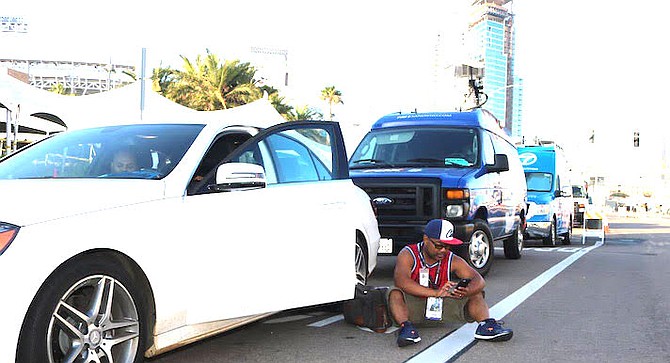
Comic-Con International 2018 did not have special parking for media/press, as in the previous years.
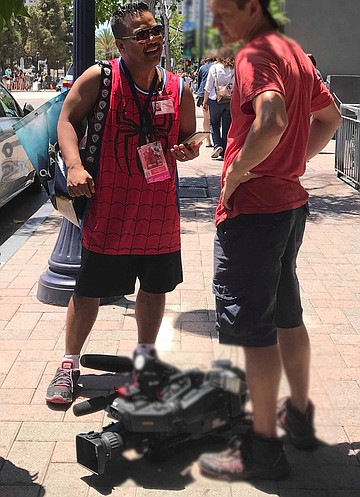
On July 18 (Wednesday), as I made a left from Harbor Drive to Park Boulevard in between the convention center’s Hall H and Hilton San Diego Bayfront garage; I was flustered.
A police volunteer wearing a light blue shirt said, “this year you’re on your own, you don’t have designated parking ….. try the back of the convention center.”
I passed Joe’s Crab Shack on the left and the Lyft Lounge on the right and entered the Embarcadero Marina Park South.
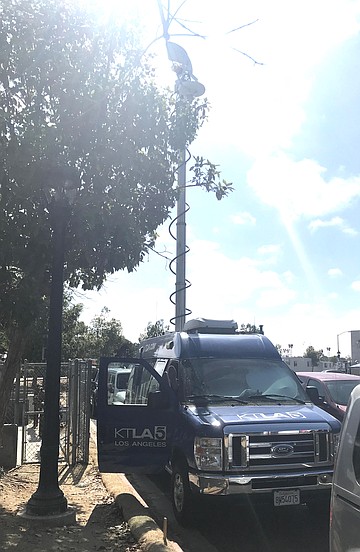
A security guard wearing a yellow shirt stopped me and said: “Pass the equipment, come around (by the fisherman area), and see if you can find a spot on this left side.”
The parking lot was full of scissor lifts, forklifts, electric carts, and no-parking signs posted throughout the cul-de-sac.
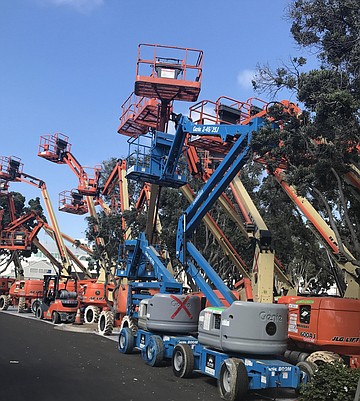
Instead of waiting for visitors to leave, or risk a hydraulic pump atop giving out, I proceeded across the street from the convention center and hoped for a safer spot.
I found an open commercial spot by the Children’s Park. With my blue colored press placard placed on my dashboard, I’m permitted to park by yellow, white, or green painted curbs — as long as I am reporting or gathering news from that area.
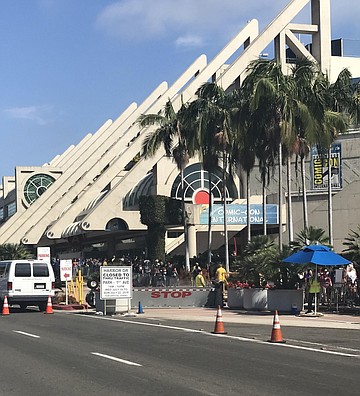
“I gotta find people that were stuck in traffic all day,” said Joe, a cameraman from a local news station.
Joe, who didn’t want me to use his real name, was interviewing my wife about how we were able to locate parking. One of the venues two blocks away was charging $70 to park; a cosplayer dressed as a “bad-guy from a 1980s sitcom” had a sign that read “I will give up my [metered] parking spot for $20.”
“When you are doing Comic-Con stories,” Joe said, “it’s essential that you are by the venue and can go live. When you don’t have media parking, you have to go back to the van and edit everything, [then send it out]. And then you have to carry your gear all the way back to the venue, again.”
Joe’s work van was parked by a white curb by Morton’s The Steakhouse. His HD camera weighs close to 40 pounds. “plus coupled with a tripod, it’s a pain,” he said.
“I did hear that Harbor Drive is closed to protect the pedestrians. And there’s been a lot of things happening in the news with people using cars as weapons. With a huge event like this, you have to take precautions.”
A metal barricade was positioned next to the loading zone entrance of the convention center by the Marriott Marquis.
Up to two years ago, the loading zone, an elevated street that runs parallel with Harbor Drive, was a prime media/press location. Reporters could park and catch the interviews by the Hall A-H doorways, and take notes or edit content between takes from their parked vehicles. For bigger production companies with boom microphones, wires, dollies, lights and multiple large cameras like Joe’s, the proximity was ideal for loading and unloading. Plus, if a reporter needs to run inside the venue, the doorways are only about 20 feet from the curb.
From Thursday to Sunday, police vehicles were parked throughout the loading zone.
On July 21 (Saturday) I saw four SY/FY production staff members walk by us at The New Children’s Museum on Island Avenue. The group just got done filming with Charlize Theron by the Hilton Bayfront, about a mile southeast of the museum. Each member was carrying large production equipment or a large bag of gear.
“Hey, may I ask you some questions,” I yelled; they kept walking and didn’t respond.
On Friday and Saturday, I saw a KTLA 5 news van parked on Park Boulevard (by the Hilton Bayfront side) by a red curb.
“It’s weird that there’s no other media parked here,” said the reporter wearing a blue shirt, “we were the only ones parked here yesterday and we didn’t have a problem.”
Before the KTLA staff left to cover Hall H, they put up their windshield sunscreen and locked up shop. The Hall H doorways were about two hundred yards away from their parked van with a large antenna jutting from the roof.
Jimmy once worked for a local hip-hop radio station; he didn’t receive a media badge for the con this year. “[Maybe] they (Comic-Con International staff) are spreading their media access to more influencers on YouTube and Instagram,” he said, “which means less access is given to radio, TV and print like you (Reader reporters). If influencers are covering the convention, they don’t need big camera equipment, staff, and preferred parking spots to report to their audience.”


Comic-Con International 2018 did not have special parking for media/press, as in the previous years.

On July 18 (Wednesday), as I made a left from Harbor Drive to Park Boulevard in between the convention center’s Hall H and Hilton San Diego Bayfront garage; I was flustered.
A police volunteer wearing a light blue shirt said, “this year you’re on your own, you don’t have designated parking ….. try the back of the convention center.”
I passed Joe’s Crab Shack on the left and the Lyft Lounge on the right and entered the Embarcadero Marina Park South.

A security guard wearing a yellow shirt stopped me and said: “Pass the equipment, come around (by the fisherman area), and see if you can find a spot on this left side.”
The parking lot was full of scissor lifts, forklifts, electric carts, and no-parking signs posted throughout the cul-de-sac.

Instead of waiting for visitors to leave, or risk a hydraulic pump atop giving out, I proceeded across the street from the convention center and hoped for a safer spot.
I found an open commercial spot by the Children’s Park. With my blue colored press placard placed on my dashboard, I’m permitted to park by yellow, white, or green painted curbs — as long as I am reporting or gathering news from that area.

“I gotta find people that were stuck in traffic all day,” said Joe, a cameraman from a local news station.
Joe, who didn’t want me to use his real name, was interviewing my wife about how we were able to locate parking. One of the venues two blocks away was charging $70 to park; a cosplayer dressed as a “bad-guy from a 1980s sitcom” had a sign that read “I will give up my [metered] parking spot for $20.”
“When you are doing Comic-Con stories,” Joe said, “it’s essential that you are by the venue and can go live. When you don’t have media parking, you have to go back to the van and edit everything, [then send it out]. And then you have to carry your gear all the way back to the venue, again.”
Joe’s work van was parked by a white curb by Morton’s The Steakhouse. His HD camera weighs close to 40 pounds. “plus coupled with a tripod, it’s a pain,” he said.
“I did hear that Harbor Drive is closed to protect the pedestrians. And there’s been a lot of things happening in the news with people using cars as weapons. With a huge event like this, you have to take precautions.”
A metal barricade was positioned next to the loading zone entrance of the convention center by the Marriott Marquis.
Up to two years ago, the loading zone, an elevated street that runs parallel with Harbor Drive, was a prime media/press location. Reporters could park and catch the interviews by the Hall A-H doorways, and take notes or edit content between takes from their parked vehicles. For bigger production companies with boom microphones, wires, dollies, lights and multiple large cameras like Joe’s, the proximity was ideal for loading and unloading. Plus, if a reporter needs to run inside the venue, the doorways are only about 20 feet from the curb.
From Thursday to Sunday, police vehicles were parked throughout the loading zone.
On July 21 (Saturday) I saw four SY/FY production staff members walk by us at The New Children’s Museum on Island Avenue. The group just got done filming with Charlize Theron by the Hilton Bayfront, about a mile southeast of the museum. Each member was carrying large production equipment or a large bag of gear.
“Hey, may I ask you some questions,” I yelled; they kept walking and didn’t respond.
On Friday and Saturday, I saw a KTLA 5 news van parked on Park Boulevard (by the Hilton Bayfront side) by a red curb.
“It’s weird that there’s no other media parked here,” said the reporter wearing a blue shirt, “we were the only ones parked here yesterday and we didn’t have a problem.”
Before the KTLA staff left to cover Hall H, they put up their windshield sunscreen and locked up shop. The Hall H doorways were about two hundred yards away from their parked van with a large antenna jutting from the roof.
Jimmy once worked for a local hip-hop radio station; he didn’t receive a media badge for the con this year. “[Maybe] they (Comic-Con International staff) are spreading their media access to more influencers on YouTube and Instagram,” he said, “which means less access is given to radio, TV and print like you (Reader reporters). If influencers are covering the convention, they don’t need big camera equipment, staff, and preferred parking spots to report to their audience.”
Comments